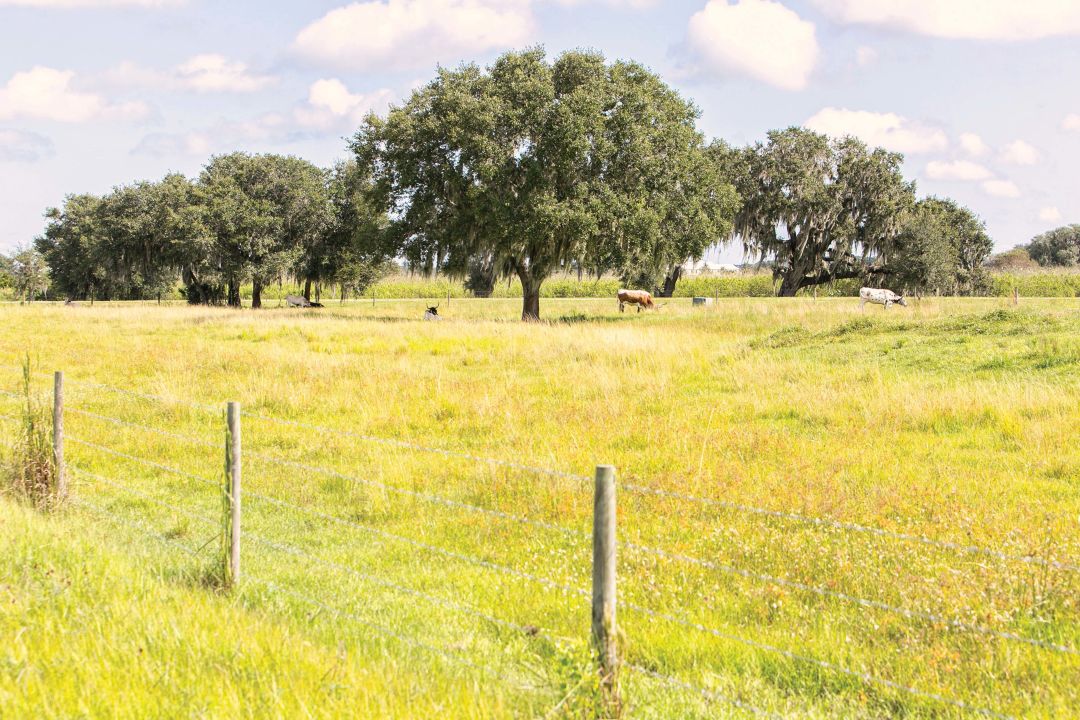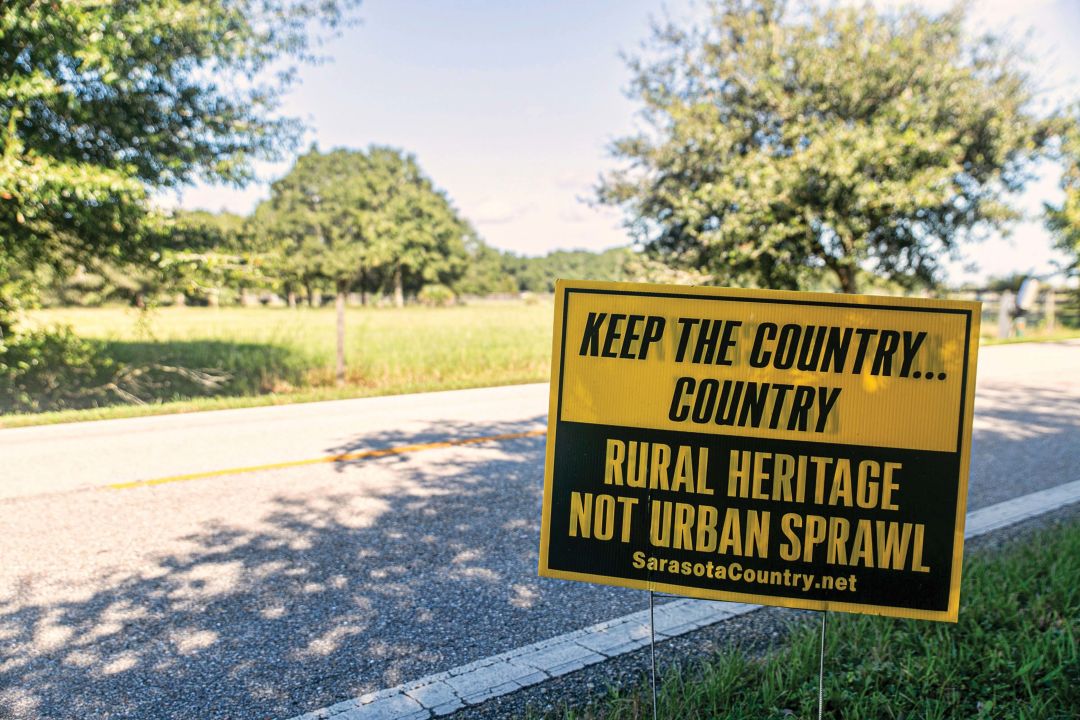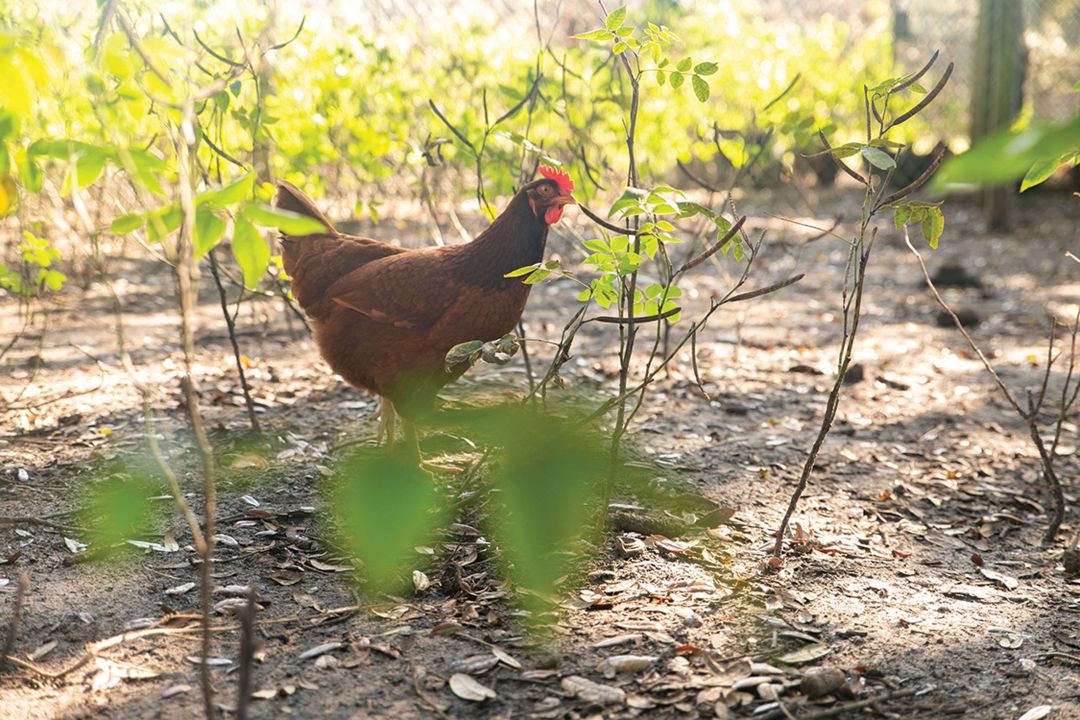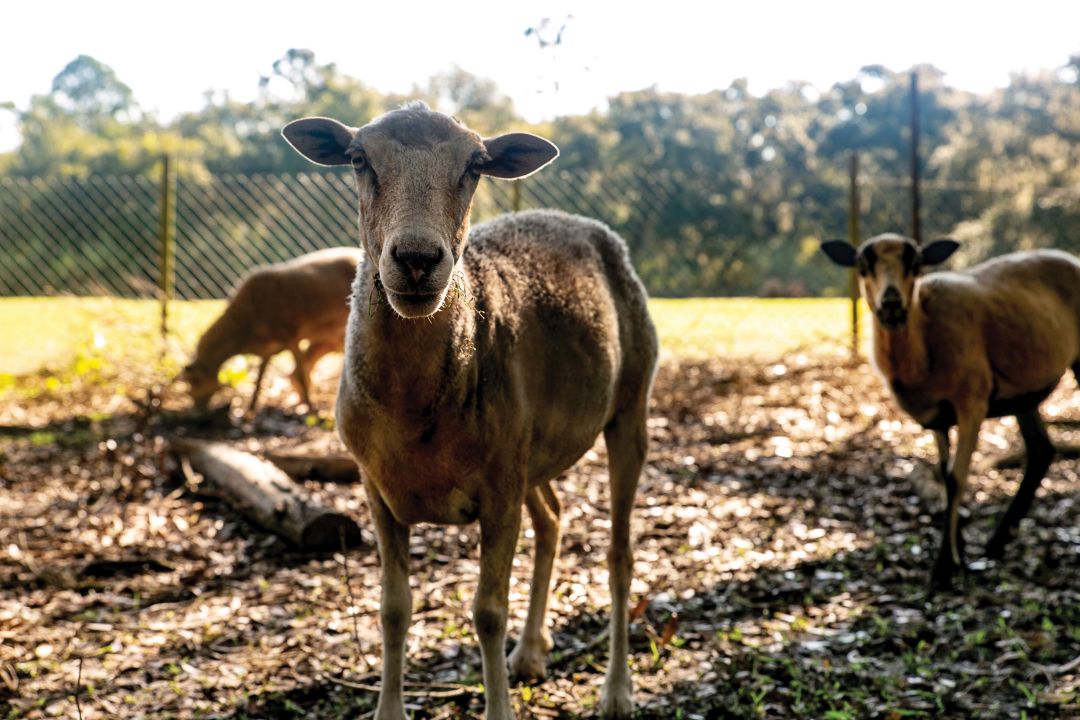
Becky Ayech Fights for Old Miakka’s Rural Way of Life
Yellow signs flit by along the miles of pastureland lining Verna Road as it heads towards Fruitville Road. “PROPOSED LAND USE CHANGE,” they read in red block capital letters.
Those warning signs jammed into the grassland weren’t always so prominent. Old Miakka resident Becky Ayech fought the county to enlarge them from an 8 ½ x 11-inch letter size to as big as a poster so her neighbors could spot them. “Who could see them driving 55 miles an hour?” she asks.
It’s not the first battle Ayech has waged, and it won’t be the last. For more than a year and a half, Ayech has fought to get Sarasota County commissioners to preserve her historic community. Those signs helped fuel a movement by Ayech and her fellow residents to ensure the 6,000 acres at the corner of Fruitville Road and Verna Road don’t give way to subdivisions like those that dot much of Sarasota.
In late September, she suffered a bitter defeat when the Sarasota County Commission unanimously voted against amending the county’s comprehensive plan to limit future development on that 6,000 acres.
“I was sorry that the commission decided to not look at the facts,” Ayech says. “It’s obvious where they were 19 years ago [when the comp plan was first adopted] isn’t where they are now.”
But Ayech isn’t deterred. For decades, she’s been battling government and developers over zoning issues, pollution and the need to protect the watershed. Her neighbor, Claudia Marvin, calls her “my Annie Oakley,” a nod to the feisty sharpshooter who mesmerized audiences in Buffalo Bill’s Wild West Show.
Ayech, who at 67 has a sprightly demeanor and on the day we met was wearing a plaid, button-down tank top, can be a performer herself. As we talk, she flips from describing the complexities of a comprehensive plan to revealing the nitty-gritty details of how a fence wasn’t enough to stop her hogs from reproducing. She looks at me with a twinkle in her eye, waiting to see if I’ll be disturbed by her description of hog lovemaking. I sense that a smile will score me a point in the Ayech playbook.
But her consuming passion over years of battles has been deeply serious: protecting the environment and the public. This time it’s about saving Old Miakka and ensuring that residents aren’t overlooked by the government that purports to represent them.
Ayech does her homework. Few politicians can match her knowledge of the minutiae of laws dating back decades; it makes her a daunting opponent, even with the odds stacked against her. Before I drove out to meet Ayech, she sent me a lengthy outline with a list of points from the county’s report on the amendment, with page numbers noted and inaccuracies highlighted in red ink.
“We’re fighting to preserve a 170-year-old rural community,” she says. “It’s about a history. Sarasota is very prolific about paving over history. We don’t want to be paved over.”
Ayech and her husband Fredj met in 1972, as adventurous young people living in Paris. Born in Tunisia, he was working for a wine company. She had come from Indiana to work as a governess.
Two years later, the couple moved to Jeffersonville, Indiana, where Ayech managed a Days Inn. She was so good that the company told her: “Anywhere you want to go, we’ll move you.” Her request was straightforward—the west coast of Florida and a liberal town. The company got the coast right but the politics wrong, choosing Republican-dominated Sarasota.
The couple visited to see if Sarasota was the right fit. At the time, topless sunbathing was allowed on North Lido Beach. They were used to that in France. As they walked along the Gulf, Ayech turned to Fredj and said, “We’ve got to move here.”
Ayech decided to keep Sarasota but quit her job at the Days Inn. She didn’t want to work 80 hours a week any longer. For their first two years, the couple lived in town. But Ayech, who grew up in rural Indiana, was called to the country. The Ayechs bought their home on Verna Road with five acres of pastureland, about 17 miles from downtown Sarasota, on the day it was listed. Ayech decided to help Fredj with his carpet installation business, and they began a new life in Old Miakka.

A pastoral scene in Old Miakka
Image: Nancy Guth
Traveling to Old Miakka is like journeying into the past. Slowly the trappings of urban and suburban life fall away, the strip malls and manicured developments, until the biggest landmark for miles is a tractor supply company.
In parts of fast-growing Sarasota, green space has almost disappeared. But in Old Miakka, the houses are set far back from the road and open pastureland reigns. The grasslands dotted with oaks and cabbage palms along the road to Old Miakka recall the early days of Florida’s history, when settlers fought through swamps and pinelands to carve out homesteads. In many places along the road, there’s no development at all, just green land topped by an immense expanse of blue sky. The only boundary ahead is the horizon.
Old Miakka’s isolation is part of its historic character. The community, which is still unincorporated, was established and settled by the Seminole tribe of Native Americans. When Europeans began to colonize the area, they were unimpressed by Old Miakka. “It is only third-rate quality and good only for its fine timber and being a good range for cattle and hogs,” one surveyor opined.
The Old Miakka neighborhood plan calculates the community’s size at 57 square miles. An 1897 population directory listed Miakka’s population as 44 and Sarasota’s as 93. The city now numbers more than 55,000 people (some 400,000 live in the county), but Ayech estimates that only 1,000 people live in Old Miakka.
It’s likely that some of those 1,000 are descendants of the 44 who lived there in 1897. Old Miakkans like to boast of their third- or fourth-generation roots. The pastureland was a fertile ground not only for grazing cattle but for people who embraced the rural lifestyle.
Living in Old Miakka is a calling. It takes a special type of person, one who wants to share his or her land with nature and “rabbits and turtles and horses,” as Ayech’s neighbor Marvin says. Or as Ayech likes to say, it appeals to people who want to grow their own food and see the closest restaurant as their own kitchen. Old Miakka residents don’t so much live on the land as they live with it.
Sometimes even those who choose Old Miakka don’t last. Ayech and Fredj call it the “five-year break.” The first five years are the make-or-break time for newcomers, as they test the ideal of living on remote farmland against the reality. They have to adjust to struggling to keep wild nature in check, traveling miles to go to the store and becoming self-reliant. If they make it five years, Ayech says, they’re here for life.
The biggest complaint you’ll hear from most residents is about traffic. The two-lane road that leads out to Old Miakka with miles of open country on either side can make you imagine you’re on the great American road trip, with the wind in your hair and the city behind you. But watch that road pile up with just a few cars and you’re not cruising so fast anymore.
There is an anxiety palpable in conversations with Ayech’s neighbors and in all her strategies and struggles. How long can this way of life survive? Claudia Marvin worries for her children and her grandchildren. Her son likes to have barbecues on her 12-acre property. Friends wanted to have their wedding on her land. But will that land and legacy be there for her grandchildren? Will the cows, the country, Florida the way it used to look remain only a drive away?
Another neighbor, Cathy Lewis, who owns 10 acres, shares that fear.
“As a native Floridian, I’ve watched all of our rural lands being gobbled up by new construction. It’s not pretty,” she says. “We’re running out of places to go.”
In a state where the landscape seems to change every day, as new development proliferates and wild lands and animals disappear, Old Miakka has remained virtually the same since its settlement. That alone is a powerful argument for its continued existence. Modern Florida is defined by Disney World, developments like Lakewood Ranch, and Miami’s international opulence. But what of the pinelands and pastures that came before? What will Florida look like when all that is paved over and communities like Old Miakka are gone? Is it worth sacrificing a historic oasis of Old Florida to gain a few thousand new homes in a faceless suburb? For Ayech and her neighbors—and they believe, for many others who may not share their way of life but appreciate that it exists—the answer is clear.
Ayech and her husband Fredj like to joke that the quiet country life they cherish is anything but quiet. The soundtrack is rich and constant: the low croaking of the frogs, the whistle of the winds, the endless hum of the katydids.

One of the Miakka Community Club’s signs.
Image: Nancy Guth
Keeping the country country is important as a contrast to the city, says Ayech. Why do New Yorkers want to escape Manhattan? They need an antidote to the hustle and bustle. “Everyone has the phrase of, ‘I’m going for a ride in the country,’” Ayech says. “They have to come out and look at the way we live. It’s a release or an enjoyment for people.” Old Miakka provides that for all of us “at no expense,” she says.
America is losing rural land as people flock to urban areas. The growth of cities has pushed urban boundaries further into rural areas, creating one subdivision after another. And that growth comes with a cost. Taxpayers foot the bill for infrastructure for roads, police and utilities.
That relentless growth has kept shifting the boundaries of Old Miakka. Residents were told in the mid-1980s that there would be no development east of I-75. Then it was east of Lorraine Road. Now, it is east of Cow Pen Slough, a 13.7-mile creek about six miles east of I-75 where multiple subdivisions already press up against the banks.
In 2001, the county adopted its 2050 plan, a blueprint to balance population growth with preservation. In the face of backlash, the county sought input from residents, including those in Old Miakka. In 2005, the county offered residents and, in particular the Miakka Community Club, of which Ayech is currently president, the opportunity to be involved in creating its own neighborhood plan.
In 2007, the county and residents agreed on a protected area for Old Miakka. No concentrated development could occur from Cow Pen Slough, the western boundary, to the Manatee County line at the north and east side, to Myakka River State Park as the southernmost point. Preferred density was agreed on at one dwelling unit per five acres maximum; no commercial development, unless it was agricultural or related to an apiary, would be allowed.
The plan, easily found on the county’s website for those who dare to wade through it, lists about 30 county staff members in its acknowledgments, and it shows an understanding of what Old Miakka’s residents want. “Of all things material, great and small, the residents’ love of the land and pastoral admiration is what they hold closest to their hearts,” begins the neighborhood plan.
Sarasota County commissioners seemed to support the plan. Residents went on with their lives, assuming that their future would look like their past, with their pastoral lands protected from dense development.
In 2014, Old Miakka residents realized the county was not following the plan. A hamlet development (defined by the 2050 plan as lower-intensity development) named Lakepark Estates was approved, calling for 400 houses on roughly 400 acres off Fruitville Road.
The development has not yet been built. But its approval stunned Old Miakka residents. Any way you looked at it, 400 houses on 400 acres didn’t fit the priorities and principles established in their neighborhood plan.
When residents came to the county reminding them what they had negotiated all those years earlier, county staff told them, Oops, sorry. The Old Miakka plan had been accepted, but not adopted, they explained. That meant it was not in effect. Instead, the county was allowing one unit per acre (the definition of a hamlet), not the one unit maximum per five acres that Old Miakka had wanted and assumed had been approved.
“We were shocked,” Ayech says. She and her neighbors, who had invested countless hours over two years working with the county, felt betrayed and alarmed.
Ayech wasn’t sure how to fight back. Then a conversation with County Commissioner Alan Maio after Hurricane Irma in 2017 about an unrelated topic spurred her thinking. When she suggested that new developments should have one designated building as a hurricane shelter, Maio suggested she write a comprehensive plan amendment proposing that.
Or, she thought, I could write an amendment to protect Miakka.

One of Ayech's 42 hens.
Image: Nancy Guth
At the same time, property owners and developers, including John Cannon and Rod Krebs, were looking to start building on roughly 3,300 acres in Old Miakka. But they ran into a problem. It would be costly to get sewer lines and utilities out to new developments. To justify that cost, they needed a density increase.
Under the name the North Fruitville Hamlet Utility Group, a cadre of 10 development entities appealed to the county to increase density in the hamlet from one unit per acre to two units per acre through a comprehensive plan amendment. That would lead to some 2,662 single-family homes on the 3,300 acres.
County staff didn’t find the argument compelling. In fact, they recommended the amendment be denied, calling it “premature and a potential contributor to urban sprawl.” Since then, part of the land has been sold and the project is now on hold, according to county planners.
But the developers’ effort galvanized Ayech. She saw a future creeping ever closer that threatened her beloved community with subdivisions and clustered houses, and she felt she had to act. Now was her time.
Ayech thought a $5,000 check was required to file a publicly initiated comprehensive plan amendment. When she marched down to the county with her check, they told her it wasn’t necessary. Since she didn’t own the land in question, she needed 20 signatures from registered voters in the unincorporated part of the county to file a proposed amendment. In true Ayech fashion, she came back the next day with double that number.
It took more than a year for a county staff report on the amendment to be presented at a virtual planning commission meeting in late August. Staff concluded that the amendment was “generally consistent with the primary tenets of Sarasota 2050,” but recommended it be denied. Ayech was baffled.
Their argument hinged largely on one point: preservation of the environment. Preservation of land is an important principle in the 2050 plan. For example, the plan stipulates that any development designated as a hamlet must keep 60 percent of its land as open space, which the county will protect as a designated conservation area. With the rural heritage/estate land use Ayech’s amendment requested, only 20 percent of any developed land can be covered by housing, meaning that 80 percent would remain open space.
But staff said they would not have the ability to permanently protect and control that conservation land. And so, with a kind of Catch-22 reasoning, the staff decided that the amendment that would have guaranteed that most land in Old Miakka remained wild and undeveloped should be rejected on environmental grounds.
At its virtual meeting, however, the planning commission seized on another reason to deny the amendment. They cited the threat of litigation from property owners who might want to develop their Old Miakka land more densely.
In Florida, the Bert Harris Act allows landowners to sue governments for losses to property value if government action negatively affects the use of a property in a way the owner could not have anticipated when they initially made their investment. The county’s deputy attorney, Joshua Moye, acknowledged at the planning commission meeting that there could be some legal risk should the amendment be approved.
Land use attorney Bill Merrill, who represented three property owners who owned roughly 4,000 of the 6,000 acres included in Ayech’s amendment, makes the distinction between a property owner seeking to change his own land rights and community members doing it for them.
“They are trying to take other people’s property and diminish their rights,” Merrill said. “They’re trying to get to somebody else’s land and downgrade the value of their land that they have owned for many, many years.”
Ayech counters that developers’ proposal for the density and utility amendment shows they are willing to change the rules that applied to their land when they purchased it. Why else would they ask the county for more density and financial assistance with infrastructure?
“They said they couldn’t build this without using taxpayer dollars and getting greater density,” she says. “So, if you admit that what is on the books, you’re not able to do, then what kind of ownership can you claim?”
During the virtual Planning Commission discussion, most commissioners did not express an interest in protecting rural lands or the character of Old Miakka. But vice chair Colin Pember, land-acquisition manager at the Atlanta-based mega-construction company Pulte Group Inc., raised objections to the county rules for submitting proposed amendments.
“I think 20 signatures are insufficient to trigger a request that the county initiate a comprehensive plan amendment that will impact property the group has no financial interest in,” said Pember. “They don’t own these lands—however, they are trying to impede on the rights of others.”
On Sept. 23, the county commission voted to withdraw Ayech’s comprehensive plan from consideration.

"Darlin'” comes when called, like each one of Ayech’s sheep.
Image: Nancy Guth
As Ayech looks around at her own land, she wonders about her rights and those of her neighbors.
Almost every inch of Ayech’s property has a purpose. There’s the fenced-in vegetable garden with rows of brown earth mounds where she grows cauliflower, turnips, broccoli, beets and five kinds of lettuce. There are the makeshift stables where she keeps her sheep, which all respond to the name she’s given them. There’s the nine-hole golf course that she and her husband have fashioned in their front yard.
Most, if not all, of her furniture and décor is salvaged, secondhand or gifts from friends. A discarded headboard and two wrought-iron chairs with a thick plank of wood in between form a back-yard bench. The canopy that shades her back patio was originally a billboard her brother brought from Indiana.
After the commission voted to withdraw her amendment, Ayech was disappointed—but not defeated. She vowed she would find another way.
Her other way came in the form of a phone conversation with Commissioner Charles Hines. Hines suggested that Ayech look into buying the development rights of the 6,000 acres referenced in the amendment. That would be a compromise between both parties: The developers could still build on the land, but the owner of the development rights would control how the land would be developed. Ayech would want the land designated as an agricultural preserve, ensuring that “what you see there now is what you’re going to get forever,” she says.
It would be much cheaper to buy the development rights than to buy the properties themselves, she explains. She hopes to get financial support from the county’s Environmentally Sensitive Lands Protection Program, which allows the county to acquire land and permanently protect it.
That process could take roughly two years, she estimates. In the meantime, she promises to fight any new development and developer that tries to intrude into the area.
“Oh, honey, yes,” she says when I ask her whether she’ll have the same reaction if another new hamlet is suggested. “On every single one.”
She admits it will be difficult. Ayech has struggled with her health in recent years, undergoing several surgeries, at least one life-threatening. It’s a reminder that her fight cannot be eternal.
After one of her last surgeries, her doctors warned her it would take three years to fully recover.
“No, it won’t,” she thought. “I’m going to go home and shovel muck.”
But even her iron will had met its match. “Recovery took three years,” she admits. “And then I’m getting older while it’s taking me a long time.”
But that hasn’t dimmed her fighting spirit. It’s possible, she says with a mischievous grin, “I’ll have to spend another 40 years fighting to keep this area country.” And if that’s what it takes, she stands ready.
“I will never go away,” she promises.
Elizabeth Djinis is a journalist based in St. Petersburg, Florida.